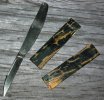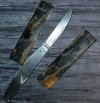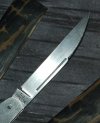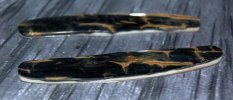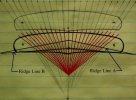pappy1959
Banned
- Joined
- May 27, 2008
- Messages
- 433
I'm working on something that I hope will be unusual and interesting.
Sheffield knives give me so much energy. Knowing what was done, and even more, HOW it was done, just sends shivers up and down my spine. The turn-of-the-century Sheffield knives are works of art that, in some cases, have never been surpassed.
So, here is my Sheffield Norfolk pen knife, in process.....................
Usually this pen knife has two small blades, but in today's world, a single blade gents is what I'm most used to. So, putting the two together just seemed to make sense. It is 3" long, closed. 154cm blade steel and 410 stainless liners.
The handle material is the black and gold mammoth ivory seen in the photos. The black coloration goes very deep. I hope it is that deep throughout both pieces.
The blade is about 2/3 finished. The blade and spring have been married and the action is fairly smooth so far. The pull-apart is shown in the photos with the scales.



Now for some hafting, some carving, maybe some filework?
So, wish me luck. Lots left to do.
Look for more pics as it moves forward.
Thanks for looking. Comments most welcome.
Keep Care,
Tim
Sheffield knives give me so much energy. Knowing what was done, and even more, HOW it was done, just sends shivers up and down my spine. The turn-of-the-century Sheffield knives are works of art that, in some cases, have never been surpassed.
So, here is my Sheffield Norfolk pen knife, in process.....................
Usually this pen knife has two small blades, but in today's world, a single blade gents is what I'm most used to. So, putting the two together just seemed to make sense. It is 3" long, closed. 154cm blade steel and 410 stainless liners.
The handle material is the black and gold mammoth ivory seen in the photos. The black coloration goes very deep. I hope it is that deep throughout both pieces.
The blade is about 2/3 finished. The blade and spring have been married and the action is fairly smooth so far. The pull-apart is shown in the photos with the scales.
Now for some hafting, some carving, maybe some filework?
So, wish me luck. Lots left to do.
Look for more pics as it moves forward.
Thanks for looking. Comments most welcome.
Keep Care,
Tim

